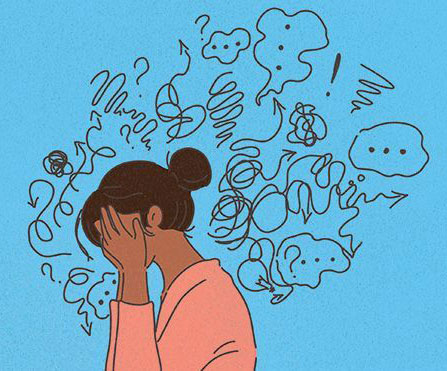Anxiety is a feeling that most of us have experienced at one time or another. Anxiety serves a practical purpose: to warn us of potential dangers. Unfortunately, in modern life, the “warning” is often outsized or simply irrational compared to the size or likelihood of the perceived threat. Whether the worry is about tests at school, weather forecasts, fear of being judged by others, or worry about feeling worried, anxiety can be frustrating at best and downright debilitating at worst.

Anxiety tends to follow a predictable pattern, called the Cycle of Anxiety, which includes the following steps:
- First comes the FEELING of anxiety, which many people experience as several uncomfortable symptoms, including intrusive thoughts, fear, racing heart rate, butterflies in the stomach, or sweating.
- Next comes AVOIDANCE. This behavior involves avoiding situations that bring about anxiety or, if the situation is unavoidable, distracting oneself from the feeling of anxiety.
- Avoidance brings SHORT-TERM RELIEF from anxiety. Avoiding a situation and feeling less distressed reinforces the idea that one should avoid the problem or stimulus causing anxiety symptoms.
- From here, anxiety GROWS BIGGER over time. Unfortunately, repeated avoidance usually leads to anxiety growing bigger, scarier, and increasingly challenging to conquer over time. From here, the cycle repeats.
Breaking the Anxiety Cycle
Thankfully, there are evidence-based methods of overcoming anxiety. Cognitive behavioral therapy (CBT) uses controlled exposure to fear-inducing thoughts and situations, which can lead to decreased anxiety symptoms over time. The following steps can serve as a roadmap for gaining control over your anxiety.
- Make a list of everything you can think of that gives you anxiety. For someone with social anxiety, this might include: going to a birthday party; conversing with people you don’t know very well; sitting with others at lunch; giving a class presentation; inviting one or more people to hang out; or attending a sleepover. Make a list as long and exhaustive as possible. Simply thinking about the things that give you anxiety and making a list is part of the exposure work!
- Now that you have a long list, rearrange the items from least anxiety-producing to most.
- Go through the list again and assign a value to each item between 0 and 100. (0=no anxiety at all. 100= the most fear you have experienced or can imagine.)
- From here, develop a plan to methodically work your way through the list, intentionally “showing up” to the situations you wrote down and tolerating the following anxiety. Intentional exposure to fearful situations is scary, but you get to decide the pace at which you will work. Start with the low numbers. If those seem too risky to start, chances are your list is too short, and you have not thought of enough lower-numbered items (e.g., 10–30 range). Keep adjusting the list until it feels like something you could see yourself working through.
- Begin your exposure work. While courageously approaching the situations you know have caused you anxiety, allow anxious thoughts and feelings to appear and resist the temptation to distract yourself or leave. Recognize that your thoughts and feelings are not dangerous but normal bodily reactions, which usually reduce naturally over time. Function in your discomfort zone and notice your achievements!
- Remember to be patient and kind to yourself. Every situation you show up for is a cause for celebration! Keep in mind that the goal is not to eradicate anxiety. It is to make it more tolerable and strengthen your ability to stay present for challenging situations rather than avoid them.
- Finally, remember that you are not alone. Share your goals and plan with friends, family, or a teacher who can help with planning, accountability, and affirmation of your progress. If your anxiety seems too big and powerful to conquer, consider working with a therapist, counselor, or other trained professional.
Posted by Chris Erb